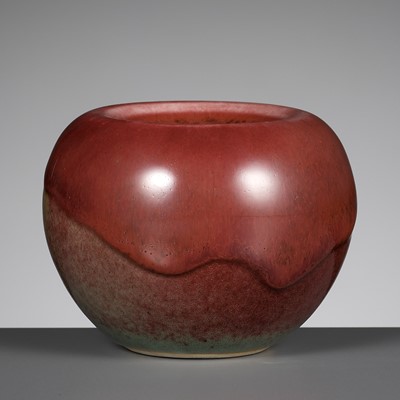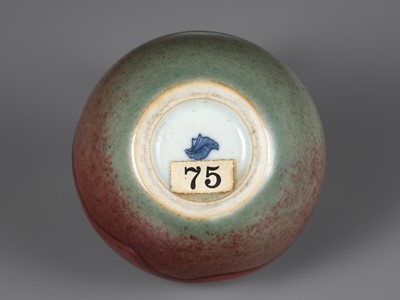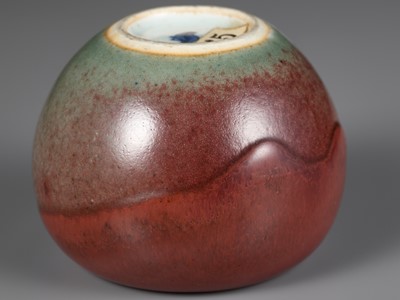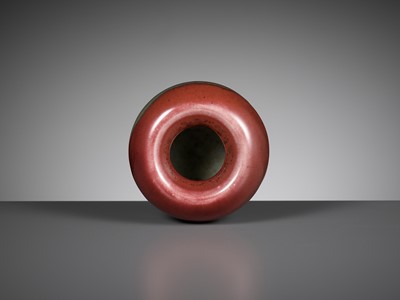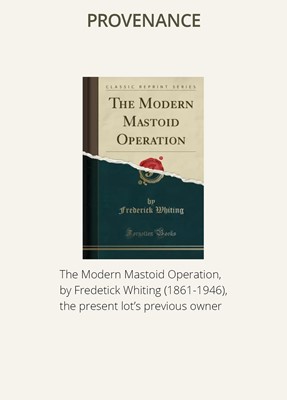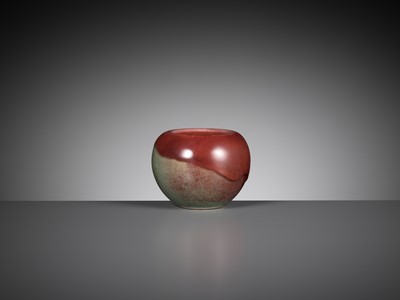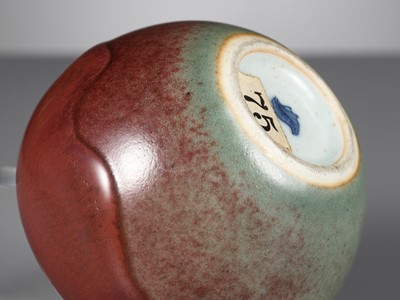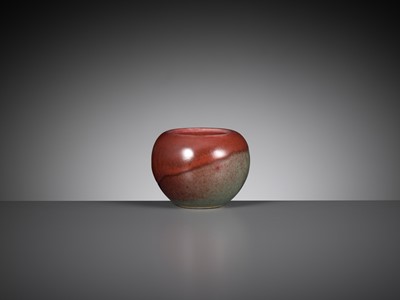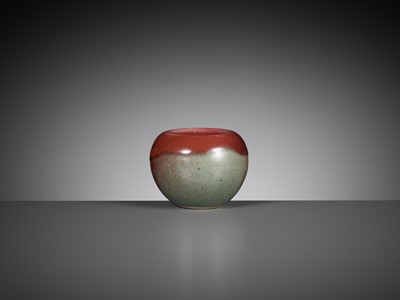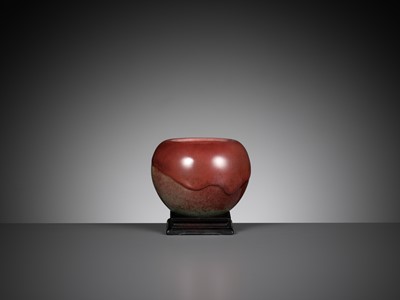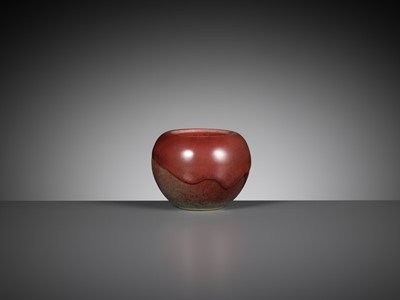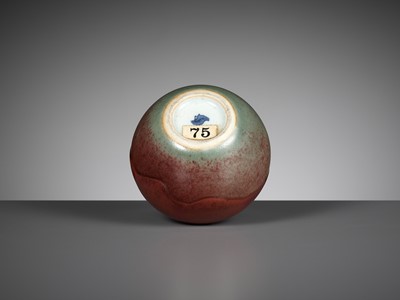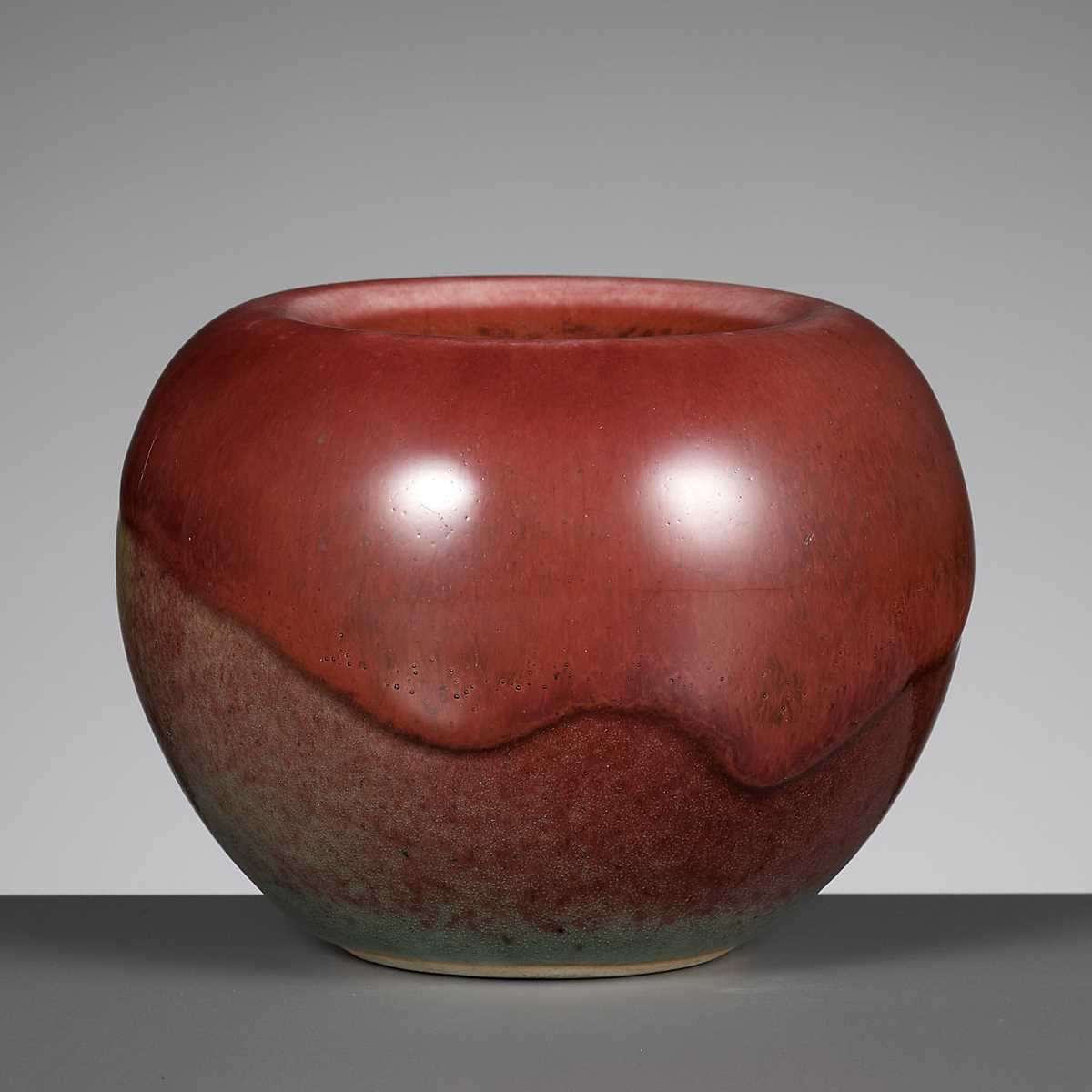10th Mar, 2023 10:00
TWO-DAY AUCTION - Fine Chinese Art / 中國藝術集珍 / Buddhism & Hinduism
402
A RARE ‘JUN-IMITATION’ WATERPOT, PINGGUOZUN, KANGXI PERIOD
康熙時期罕見仿鈞釉蘋果尊
Sold for €3,640
including Buyer's Premium
Opinion: No other examples of this specific glaze type, combined with this specific form and mark, appear to have come on the market. The unique imitation Jun ware purplish-red glaze, derived from copper, combined with the simple apple-form and auspicious artemisia leaf mark, firmly places the jar within the Kangxi period. The high age of the jar is further cemented by its early provenance.
China, 1662-1722. Delicately potted, the 'apple jar' is of compressed globular form with an inverted rim, covered overall in an elegant purplish-red, somewhat experimental glaze, attractively and irregularly pooling below the mouth and transmuting to a bluish celadon, building a distinct line of glaze drops in remarkably high relief around the central body. The white base with an underglaze-blue artemisia leaf mark.
Provenance: From the collection of Dr. Frederick Whiting (1861-1946), mostly assembled before 1930, and thence by descent in the same family. The base with an old label, ‘75’. An 1890 graduate of the University of Vienna, Austria, Dr. Whiting was a Fellow of the American College of Surgeons and a member of the American Otological Society, the New York Otological Society, and the New York Academy of Medicine. Dr. Whiting was also a member of numerous clubs, among others the New York Athletic Club, the Clove Valley Rod and Gun Club, the Century Association, and the Society of Cincinnati in the State of Connecticut. He was a recognized collector of American paintings and Chinese porcelains, and a respected author, having written numerous scientific articles as well as a book on surgical techniques titled The Modern Mastoid Operation.
Condition: Excellent condition with minor wear and firing irregularities, with a subtle orange tinge to the foot rim and stained craquelure to the interior.
Dimensions: Height 6.4 cm (excl. stand), Diameter 8.5 cm
Weight: 237 g (excl. stand)
With a finely carved zitan stand. (2)
When the Kangxi Emperor came to the throne, he immediately began to show an interest in the production of porcelain and encouraged the potters to experiment, improve and rediscover earlier techniques. One of those rediscoveries was the attempt at replicating Jun ware of the Song Dynasty, remarkable for its thick luscious glaze of intense coloration which can vary from light to deep turquoise blue splashed with purplish-red derived from copper. The splashes added a flamboyant effect, which had an immense appeal to the literati and nobility of the time. The present lot seems to be one of the rather early prototypes from this group.
During the early Qing dynasty, up until the early 1680s, conditions were unsettled in China and the making of Imperial wares as well as the use of reign marks on porcelain was restricted in various ways. During this period, different types of other marks came into use, including artemisia leaf marks.
康熙時期罕見仿鈞釉蘋果尊
中國,1662-1722年。器呈侈口,無頸、圓腹,器口頸若果蒂下凹於圓腹之中,底內凹。器體小巧玲瓏,豐滿圓潤。全器施玫紅色仿均釉,近足部成淺藍色,釉色流淌和緩且變化自然。圈足內施白地青花蒿葉款。
專家注釋: 市場上似乎沒有這種特殊釉面類型的例子,並帶有這種特殊款識標記。獨特的仿鈞窯玫紅色釉料,以銅為原料,結合簡潔的蘋果形和吉祥的蒿葉款,所以此罐應來自康熙時期。
來源:Dr. Frederick Whiting (1861-1946) 收藏,大多藏品購於1930年前,在同一家族保存至今。底座有一個老標籤 ‘75’。 Whiting 博士於 1890 年畢業於奧地利維也納大學,是美國外科醫學院的院士,也是美國耳科學會、紐約耳科學會和紐約醫學院的成員。 Whiting博士還是許多俱樂部的成員,其中包括紐約運動俱樂部、丁香穀杆槍俱樂部、世紀協會和康涅狄格州辛辛那提協會。 他是一位公認的美國繪畫和中國瓷器收藏家,也是一位受人尊敬的作家,撰寫了大量科學文章以及一本名為《The Modern Mastoid Operation》的外科技術書籍。
品相:品相極佳,有輕微磨損和燒製不規則,足緣略帶橙色,內部有裂紋。
尺寸:高 6.4 釐米 (不含底座),直徑 8.5 釐米
重量:237 克 (不含底座)
紫檀雕刻底座。 (2)
Opinion: No other examples of this specific glaze type, combined with this specific form and mark, appear to have come on the market. The unique imitation Jun ware purplish-red glaze, derived from copper, combined with the simple apple-form and auspicious artemisia leaf mark, firmly places the jar within the Kangxi period. The high age of the jar is further cemented by its early provenance.
China, 1662-1722. Delicately potted, the 'apple jar' is of compressed globular form with an inverted rim, covered overall in an elegant purplish-red, somewhat experimental glaze, attractively and irregularly pooling below the mouth and transmuting to a bluish celadon, building a distinct line of glaze drops in remarkably high relief around the central body. The white base with an underglaze-blue artemisia leaf mark.
Provenance: From the collection of Dr. Frederick Whiting (1861-1946), mostly assembled before 1930, and thence by descent in the same family. The base with an old label, ‘75’. An 1890 graduate of the University of Vienna, Austria, Dr. Whiting was a Fellow of the American College of Surgeons and a member of the American Otological Society, the New York Otological Society, and the New York Academy of Medicine. Dr. Whiting was also a member of numerous clubs, among others the New York Athletic Club, the Clove Valley Rod and Gun Club, the Century Association, and the Society of Cincinnati in the State of Connecticut. He was a recognized collector of American paintings and Chinese porcelains, and a respected author, having written numerous scientific articles as well as a book on surgical techniques titled The Modern Mastoid Operation.
Condition: Excellent condition with minor wear and firing irregularities, with a subtle orange tinge to the foot rim and stained craquelure to the interior.
Dimensions: Height 6.4 cm (excl. stand), Diameter 8.5 cm
Weight: 237 g (excl. stand)
With a finely carved zitan stand. (2)
When the Kangxi Emperor came to the throne, he immediately began to show an interest in the production of porcelain and encouraged the potters to experiment, improve and rediscover earlier techniques. One of those rediscoveries was the attempt at replicating Jun ware of the Song Dynasty, remarkable for its thick luscious glaze of intense coloration which can vary from light to deep turquoise blue splashed with purplish-red derived from copper. The splashes added a flamboyant effect, which had an immense appeal to the literati and nobility of the time. The present lot seems to be one of the rather early prototypes from this group.
During the early Qing dynasty, up until the early 1680s, conditions were unsettled in China and the making of Imperial wares as well as the use of reign marks on porcelain was restricted in various ways. During this period, different types of other marks came into use, including artemisia leaf marks.
康熙時期罕見仿鈞釉蘋果尊
中國,1662-1722年。器呈侈口,無頸、圓腹,器口頸若果蒂下凹於圓腹之中,底內凹。器體小巧玲瓏,豐滿圓潤。全器施玫紅色仿均釉,近足部成淺藍色,釉色流淌和緩且變化自然。圈足內施白地青花蒿葉款。
專家注釋: 市場上似乎沒有這種特殊釉面類型的例子,並帶有這種特殊款識標記。獨特的仿鈞窯玫紅色釉料,以銅為原料,結合簡潔的蘋果形和吉祥的蒿葉款,所以此罐應來自康熙時期。
來源:Dr. Frederick Whiting (1861-1946) 收藏,大多藏品購於1930年前,在同一家族保存至今。底座有一個老標籤 ‘75’。 Whiting 博士於 1890 年畢業於奧地利維也納大學,是美國外科醫學院的院士,也是美國耳科學會、紐約耳科學會和紐約醫學院的成員。 Whiting博士還是許多俱樂部的成員,其中包括紐約運動俱樂部、丁香穀杆槍俱樂部、世紀協會和康涅狄格州辛辛那提協會。 他是一位公認的美國繪畫和中國瓷器收藏家,也是一位受人尊敬的作家,撰寫了大量科學文章以及一本名為《The Modern Mastoid Operation》的外科技術書籍。
品相:品相極佳,有輕微磨損和燒製不規則,足緣略帶橙色,內部有裂紋。
尺寸:高 6.4 釐米 (不含底座),直徑 8.5 釐米
重量:237 克 (不含底座)
紫檀雕刻底座。 (2)
Zacke Live Online Bidding
Our online bidding platform makes it easier than ever to bid in our auctions! When you bid through our website, you can take advantage of our premium buyer's terms without incurring any additional online bidding surcharges.
To bid live online, you'll need to create an online account. Once your account is created and your identity is verified, you can register to bid in an auction up to 12 hours before the auction begins.
Intended Spend and Bid Limits
When you register to bid in an online auction, you will need to share your intended maximum spending budget for the auction. We will then review your intended spend and set a bid limit for you. Once you have pre-registered for a live online auction, you can see your intended spend and bid limit by going to 'Account Settings' and clicking on 'Live Bidding Registrations'.
Your bid limit will be the maximum amount you can bid during the auction. Your bid limit is for the hammer price and is not affected by the buyer’s premium and VAT. For example, if you have a bid limit of €1,000 and place two winning bids for €300 and €200, then you will only be able to bid €500 for the rest of the auction. If you try to place a bid that is higher than €500, you will not be able to do so.
Online Absentee and Telephone Bids
You can now leave absentee and telephone bids on our website!
Absentee Bidding
Once you've created an account and your identity is verified, you can leave your absentee bid directly on the lot page. We will contact you when your bids have been confirmed.
Telephone Bidding
Once you've created an account and your identity is verified, you can leave telephone bids online. We will contact you when your bids have been confirmed.
Classic Absentee and Telephone Bidding Form
You can still submit absentee and telephone bids by email or fax if you prefer. Simply fill out the Absentee Bidding/Telephone bidding form and return it to us by email at office@zacke.at or by fax at +43 (1) 532 04 52 20. You can download the PDF from our Upcoming Auctions page.
How-To Guides
How to Create Your Personal Zacke Account
How to Register to Bid on Zacke Live
How to Leave Absentee Bids Online
How to Leave Telephone Bids Online
中文版本的操作指南
创建新账号
注册Zacke Live在线直播竞拍(免平台费)
缺席投标和电话投标
Third-Party Bidding
We partner with best-in-class third-party partners to make it easy for you to bid online in the channel of your choice. Please note that if you bid with one of our third-party online partners, then there will be a live bidding surcharge on top of your final purchase price. You can find all of our fees here. Here's a full list of our third-party partners:
- 51 Bid Live
- EpaiLive
- ArtFoxLive
- Invaluable
- LiveAuctioneers
- the-saleroom
- lot-tissimo
- Drouot
Please note that we place different auctions on different platforms. For example, in general, we only place Chinese art auctions on 51 Bid Live.
Bidding in Person
You must register to bid in person and will be assigned a paddle at the auction. Please contact us at office@zacke.at or +43 (1) 532 04 52 for the latest local health and safety guidelines.
